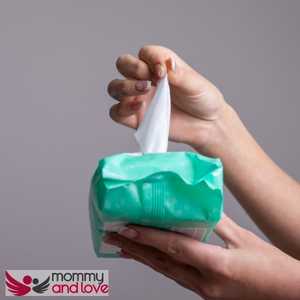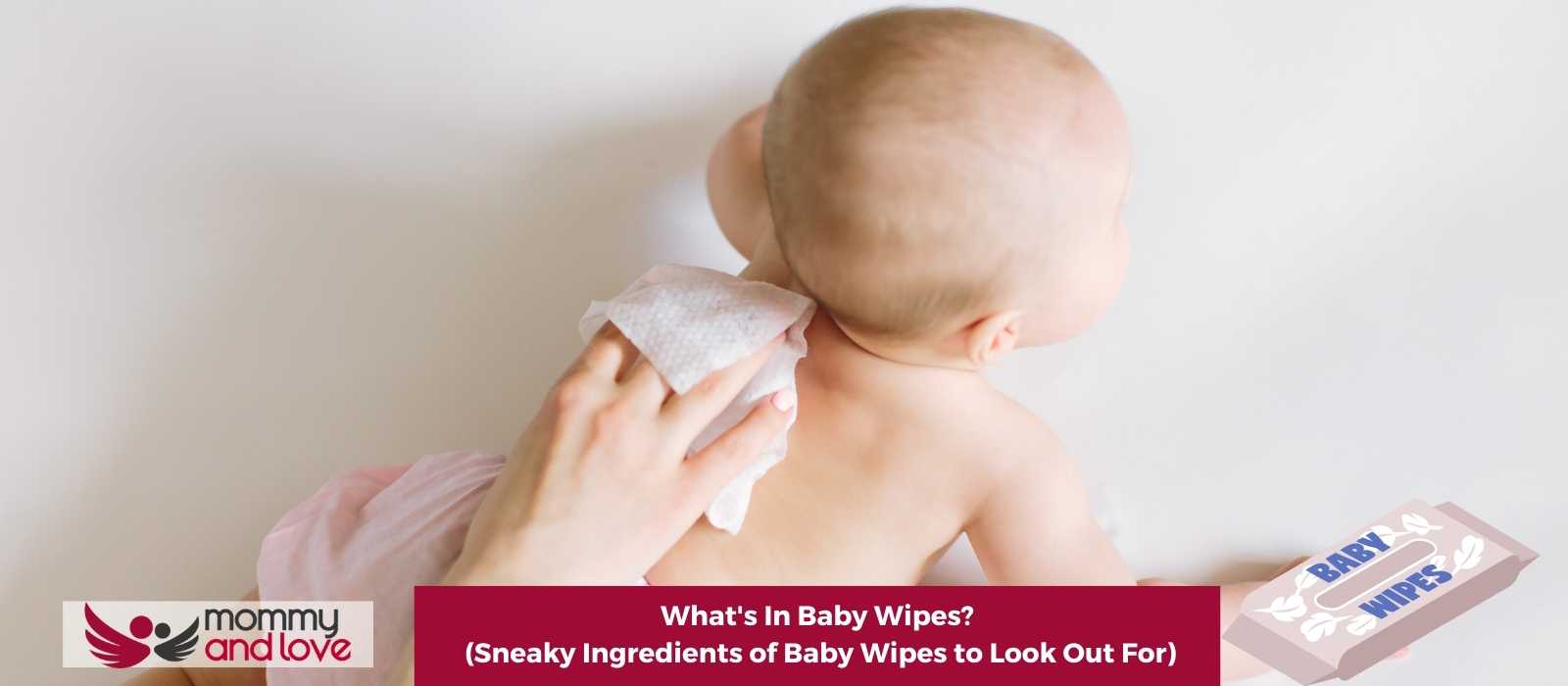When it comes to baby wipes, we often think that they are just made of water and cotton. However, most commercial baby wipes contain a cocktail of chemicals that can be harmful to your baby’s delicate skin. We dig deep into exactly what’s making up those wipes and why they are not as pure, innocent or sensitive as their clever marketing materials claim!
What is A Baby Wipe Made Up Of?

A baby wipe consists of the base cloth and then a mixture of water and other ingredients depending on the brand.
The base cloth is usually made from a blend of rayon and polyester (plastic).
The wipes are then saturated in a solution that contains:
Water: This is usually the main ingredient in most baby wipes.
Cleansers: These help to break down dirt, oil and grime on your baby’s skin. The most common cleansers used in baby wipes are sodium laureth sulfate and Cocamidopropyl betaine.
Preservatives: Baby wipes need to have some form of preservative to stop them from going moldy. The most commonly used preservative in baby wipes is phenoxyethanol.
Perfumes: To make the wipes smell nice, manufacturers will add synthetic fragrances to the mix.
Dyes: Some baby wipes also contain artificial dyes to make them look more appealing.
What’s Wrong With These Ingredients?
Now that we know what is in baby wipes, let’s take a look at why these ingredients might not be the best for your baby’s skin.
Bronopol:
This is a common preservative used in baby wipes. It is a known irritant and has been linked to cancer.
Chlorhexidine:
This is an antiseptic ingredient that is used in some baby wipes. It can cause allergic reactions and skin irritation.
DMDM hydantoin
This is another preservative that is commonly used in baby wipes. It releases formaldehyde, a known carcinogen.
Fragrance / Parfum
Most commercial baby wipes contain synthetic fragrances. These can cause skin irritation and allergic reactions.
Iodopropynyl butylcarbamate
This is a common preservative used in baby wipes. It is an eye and skin irritant.
Phenoxyethanol
This is a preservative that is commonly used in baby wipes. It can cause allergic reactions, vomiting and diarrhea.
Polysorbate 20
This is an emulsifier that is used in some baby wipes. It can cause skin irritation.
Propylene glycol
This is a moisturizing ingredient that is used in some baby wipes. It can cause skin irritation, and with prolonged contact can cause organ system toxicity.
Sodium benzoate
This is a preservative that is used in some baby wipes. It can release cancer-causing chemicals when it reacts with other ingredients. This can be listed as Benzoic acid.
Sodium laureth sulfate or Sodium Lauryl Sulfate
This is a cleanser that is used in most baby wipes. It can cause skin irritation.
Triclosan
This is an antibacterial ingredient that is used in some baby wipes. It can disrupt the endocrine system and cause antibiotic resistance.
Phthalates
These are a group of chemicals that are used to make plastics more flexible. They can leach into baby wipes and cause health problems.
Methylisothiazolinone (MIT)
This is a preservative that is used in some baby wipes. It can cause allergic reactions and skin irritation.
Parabens
These are a group of preservatives that are used in most baby wipes. They can disrupt the endocrine system and have been linked to cancer.
benzyl alcohol
This is a preservative that is used in some baby wipes. It can cause allergic reactions and skin irritation. It has now been recommended not to use this in baby products.
PEGs
These are a group of chemicals that are used to make plastics more flexible. They can leach into baby wipes and cause health problems. These can include ethylene oxide.
Triclosan
This is an antibacterial ingredient that is used in some baby wipes. It can disrupt the endocrine system and cause antibiotic resistance.
Alcohol
Some baby wipes contain alcohol, which can be drying and irritating for your baby’s skin. These can cause diaper rash to become worse.
So as you can see, there are a few reasons why you might want to avoid using commercial baby wipes on your baby’s skin. If you are looking for an alternative, why not try making your own DIY baby wipes
What Are The Alternatives?
If you are concerned about the ingredients in commercial baby wipes, there are some alternative options that you can use. The best non-toxic baby wipes tend to be organic cotton wipes or just homemade wipes. Water wipes are a new brand that just uses grapefruit seed extract as a preservative if you want rather continue to use disposable baby wipes. It’s great for sensitive skin and I would consider it one of the safe baby wipes options.
You could make your own baby wipes using natural ingredients such as water, olive oil or coconut oil if you want to avoid baby wipes.
Another option is to use cloth wipes instead of disposable wipes. You can buy a pack of cloth wipes, or you could make your own using old-fashioned flannel squares or hemp rounds.
Finally, if you want something that is both natural and disposable, you could try using organic baby wipes. These wipes are made from bamboo or cotton, and they are free from harmful chemicals.
Do baby wipes have chemicals in them?

Yes, baby wipes often contain chemicals that can be harmful to your baby’s skin.
These chemicals can cause skin irritation, allergic reactions, and in some cases, cancer.
Some of the most common dangerous chemicals which you want to avoid in baby wipes are bronopol, chlorhexidine, DMDM hydantoin, formaldehyde, iodopropynyl butylcarbamate, phenoxyethanol, polysorbate 20, propylene glycol, sodium benzoate, sodium laureth sulfate, triclosan, phthalates, methylisothiazolinone (MIT), parabens and PEGs.
Very few brands of popular baby wipes don’t contain hidden ingredients which many of use would consider harmful ingredients. These synthetic ingredients can often cause contact dermatitis and worse as skin is the biggest organ in the body we just don’t know what they could be doing!
Are baby wipes toxic?
While baby wipes are not technically toxic, they can contain harmful chemicals that can be dangerous to your baby’s health. These chemicals can cause skin irritation, allergic reactions, and in some cases, cancer. Some of the most common dangerous chemicals found in baby wipes are bronopol, chlorhexidine, DMDM hydantoin, formaldehyde, iodopropynyl butylcarbamate, phenoxyethanol, polysorbate 20, propylene glycol, sodium benzoate, sodium laureth sulfate, triclosan, phthalates, methylisothiazolinone (MIT), parabens and PEGs.
If you want non-toxic baby wipes and want to avoid all toxic chemicals then you need to use natural baby wipes (water wipes or Jackson Reece wipes are about the best) or reusable baby wipes. You can just use facecloths for baby wipes and mix them with essential oils.
What About Hypoallergenic or Gentle Wipes?
Baby wipes are sometimes marketed as being ‘pure’, ‘sensible’, ‘light’ ‘sensible’, ‘smooth’, ‘gently’, ‘hypoallergenic’ and ‘dermatologically tested’. This was merely a marketing slogan. There is no legal or regulatory definition for the term “hypoallergenic”. So, it is important that you still read the ingredient list on the baby wipes package before buying them, to make sure that they do not contain any of the harmful chemicals mentioned above.
Even unscented wipes and sensitive wipes versions of disposable baby wipes have a long list of ingredients to avoid. So whilst they might be fragrance-free, this does not mean toxin-free!
Look for wipes that use citric acid or sodium citrate as their preservative and the best baby wipes will use aloe vera or aloe barbadensis leaf extract to help heal the skin.
What about Biodegradable baby wipes?
While biodegradable baby wipes are a step in the right direction, they are not necessarily any better for your baby’s skin than regular baby wipes. This is because they still often contain harmful chemicals and toxic ingredients, such as parabens, phthalates, and PEGs. So, it is important that you still read the ingredient list onthe baby wipes package before buying them, to make sure that they do not contain any of the harmful chemicals mentioned above.
Biodegradable baby wipes are often made from wood pulp or bamboo, though they should never be flushed down the toilet.
Mainstream baby wipes have, like most baby products, improved a lot in recent years. Believe it or not, disposable diaper wipes contain less toxic ingredients compared to older versions of these wet wipes. Ingredients in baby wipes have always been a bit dubious, to say the least!
The Bottom Line on wet wipe ingredients
If you want to avoid using harsh chemicals on your baby’s skin, then take a long deep look at the baby wipe ingredients list. We suggest that the best baby wipes are either water wipes, Jackson Reece or organic baby wipes. However, now might be the time to consider alternatives like reusable baby wipes which are not only much better but also plastic-free and will save you money!

This article was written by: Gian MIller – Full-Time Writer, Baby Whisperer & Dad of 3.
Gian spends a lot of his time writing. A self-proclaimed baby whisperer, Gian has been through it all with his own children and is passionate about sharing his hard-won wisdom with other parents. When he’s not writing or changing diapers, you can find him playing the guitar or watching baseball (or preferably both at the same time).




